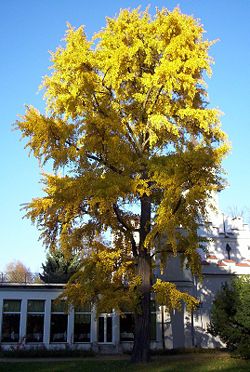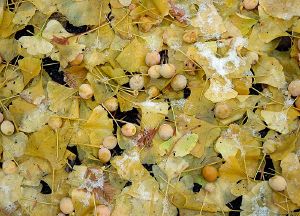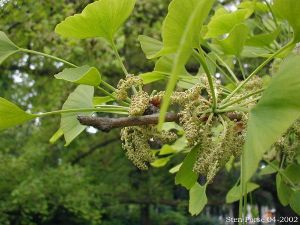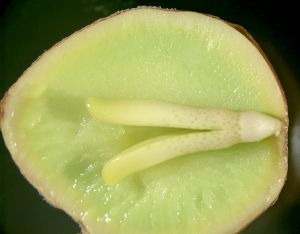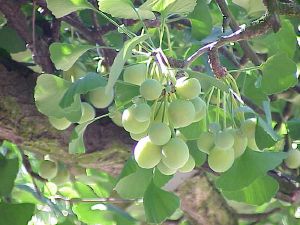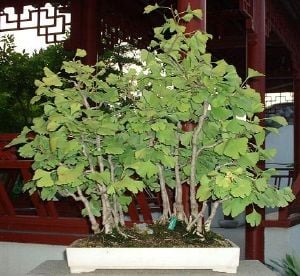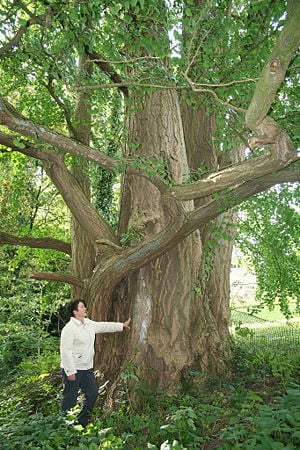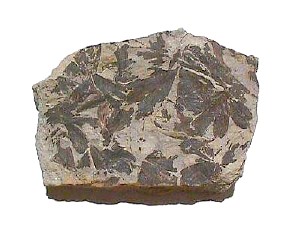Ginkgo
| Ginkgo
| ||||||||||||
|---|---|---|---|---|---|---|---|---|---|---|---|---|
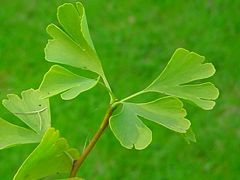 Ginkgo leaves
| ||||||||||||
| Scientific classification | ||||||||||||
| ||||||||||||
|
G. biloba L. |
The ginkgo (Ginkgo biloba; 'éæ' in Chinese; plural ginkgoes), also known as the maidenhair tree, is a unique tree with no close living relatives. It is classified in its own division, the Ginkgophyta, comprising the single class Ginkgoopsida, order Ginkgoales, family Ginkgoaceae, genus Ginkgo and is the only extant species within this group. It is one of the best known examples of a living fossil, with fossils recognizably similar to the modern species tracing back 270 million years.
Ginkgoes are towering, slender, deciduous trees, which are long lived due to a beneficial combination of disease-resistant characteristics. For centuries it was thought to be extinct in the wild, but is now known to grow in at least two small areas in Zhejiang province in Eastern China, in the Tian Mu Shan Reserve. Ginkgo trees in these areas may have been tended and preserved by Chinese monks for over 1,000 years. Therefore, the existence of native ginkgo populations is uncertain.
The relationship of ginkgo to other plant groups remains uncertain. It has been placed loosely in the divisions Spermatophyta and Pinophyta, but no consensus has been reached. Since ginkgo seeds are not protected by an ovary wall, it can morphologically be considered a gymnosperm. The apricot-like structures produced by female ginkgo trees are technically not fruits, but are the seeds, having a shell that consists of a soft and fleshy section (the sarcotesta), and a hard section (the sclerotesta).
Cultivated predominantly in China, but also commonly in other Southeast Asian countries, ginkgoes offer ornamental, culinary, and medicinal values. Their uniqueness and long life (some are believed to be 1,500 years old) add to the wonder of nature for humans. Parts of the ginkgo tree are commonly added to foods and drinks or taken as a supplement due to its desirable, yet debated health benefits.
Characteristics
General Morphology
Ginkgoes are very large deciduous trees, normally reaching a height of 20â35Â meters (66-115 feet), with some specimens in China being over 50Â meters (164 feet). The tree has an often angular crown and long, somewhat erratic branches, and is usually deep rooted and resistant to wind and snow damage. Young trees are often tall and slender, and sparsely branched; the crown becomes broader as the tree ages. During autumn, the leaves turn a bright yellow, then fall, sometimes within a short space of time (1â15Â days). A combination of resistance to disease, insect-resistant wood, and the ability to form aerial roots and sprouts makes ginkgoes very long-lived, with some specimens claimed to be more than 2,500Â years old: A 3,000 year-old ginkgo has been reported in Shandong province in China (Lewington and Parker 1999).
Some old ginkgoes produce aerial roots, known as chichi (Japanese; "nipples") or zhong-ru (Mandarin Chinese), which form on the undersides of large branches and grow downwards. Chichi growth is very slow, and may take hundreds of years to occur. The function, if any, of these thick aerial roots is unknown.
Stem
Ginkgo branches grow in length by the growth of shoots with regularly spaced leaves, as seen on most trees. From the axils of these leaves, "spur shoots" (also known as short shoots) develop on second-year growth. Short shoots have very short internodes (so that several years' growth may only extend them by a centimeter or two) and their leaves are ordinarily unlobed. They are short and knobby, and are arranged regularly on the branches, except on first-year growth. Because of the short internodes, leaves appear to be clustered at the tips of short shoots, and reproductive structures are formed only on them.
In ginkgoes, as in other plants that possess them, short shoots allow the formation of new leaves in the older parts of the crown. After a number of years, a short shoot may change into a long (ordinary) shoot, or vice versa.
Leaves
Ginkgo leaves are unique among seed plants, being fan-shaped with veins radiating out into the leaf blade, sometimes bifurcating (splitting) but never anastomosing to form a network (UCMP 2007b). Two veins enter the leaf blade at the base and fork repeatedly in two; this is known as dichotomous venation. The leaves are usually 5-10 centimeters (2-4 inches), but sometimes up to 15 centimeters (6 inches) long. The old popular name "maidenhair tree" was given because the leaves resemble some of the pinnae of the maidenhair fern, Adiantum capillus-veneris.
Leaves of long shoots are usually notched or lobed, but only from the outer surface, between the veins. They are borne both on the more rapidly-growing branch tips, where they are alternate and spaced out, and also on the short, stubby spur shoots, where they are clustered at the tips.
Reproduction
Ginkgoes are dioecious, with separate sexes, some trees being female and others being male. Male plants produce small pollen cones with sporophylls each bearing two microsporangia (male pollen-producing part called "anthers") spirally arranged around a central axis.
Female plants do not produce cones. Two ovules are formed at the end of a stalk, and after pollination, one or both develop into seeds.
The ginkgo seed is 1.5-2 centimeters long. Its fleshy outer layer, the sarcotesta, is light yellow-brown, soft, and fruit-like. It is attractive in appearance, but contains butanoic acid and smells like rancid butter (which contains the same chemical) or feces when fallen. Beneath the sarcotesta is the hard sclerotesta, normally known as the "shell" of the seed, and a papery endotesta, with the nucellus, the central cavity of the ovule, surrounding the female gametophyte. (UCMP 2007a).
The fertilization of ginkgo seeds occurs via motile sperm, as in cycads, ferns, mosses, and algae. The sperm are large (about 250-300 micrometers) and are similar to the sperm of cycads, which are slightly larger. Ginkgo sperm were first discovered by the Japanese botanist Sakugoro Hirase in 1896 (DPFSUT 2001). The sperm have a complex multi-layered structure, which is a continuous belt of basal bodies that form the base of several thousand flagella, which actually have a cilia-like motion. The flagella/cilia apparatus pulls the body of the sperm forwards. The sperm have only a tiny distance to travel to the archegonia, of which there are usually two or three. Two sperm are produced, one of which successfully fertilizes the ovule. Although it is widely held that fertilization of ginkgo seeds occurs just before or after they fall in early autumn, embryos ordinarily occur in seeds just before and after they drop from the tree (UCMP 2007a; UCMP 2007b; Holt and Rothwell 1997).
Cultivation and uses
Ginkgo has long been cultivated in China; some planted trees at temples are believed to be over 1,500 years old. The first record of Europeans encountering it is in 1690 in Japanese temple gardens, where the tree was seen by the German botanist Engelbert Kaempfer. Because of its status in Buddhism and Confucianism, the ginkgo is also widely planted in Korea and parts of Japan; in both areas, some naturalization has occurred, with ginkgos seeding into natural forests.
In some areas, notably the United States, most intentionally planted ginkgoes are male cultivars grafted onto plants propagated from seed, because the male trees will not produce the malodorous seeds. The popular cultivar "Autumn Gold" is a clone of a male plant.
The ginkgo has the intriguing distinction of being one of the world's most urban-tolerant trees, often growing where other trees cannot survive. Ginkgoes rarely suffer disease problems, even in urban conditions, and are attacked by few insects. For this reason, and for their general beauty, ginkgoes are excellent urban and shade trees, and are widely planted along many streets. The ginkgo is the official tree of the city of Kumamoto, and two leaves form the symbol of the University of Tokyo, the main campus of which is famous for its numerous ginkgoes.
Ginkgoes are also popular subjects for growing as penjing and bonsai; they can be kept artificially small and tended over centuries. Furthermore, the trees are easy to propagate from seed.
Extreme examples of the ginkgo's tenacity may be seen in Hiroshima, Japan, where four trees growing between 1â2Â kilometers from the 1945 atom bomb explosion were among the few living things in the area to survive the blast. While almost all other plants (and animals) in the area were destroyed, the ginkgoes, though charred, survived and were soon healthy again. The trees are alive to this day.
Culinary use
The nut-like gametophytes inside the seeds are particularly esteemed in Asia, and are a traditional Chinese food. Called yÃn xìng (é¶æ; literally "silver apricot") or bái guÇ (ç½æ; literally "white fruit"), ginkgo nuts are used in congee, a chinese porriage, and are often served at special occasions such as weddings and the Chinese New Year (as part of the vegetarian dish called Buddha's delight). In Chinese culture, they are believed to have health benefits; some also consider them to have aphrodisiac qualities. Japanese cooks add Ginkgo seeds to dishes such as chawanmushi, and cooked seeds are often eaten along with other dishes. The seeds are available canned, sold as "white nuts," and can be found in many Asian food stores in the West. Usually only a few are added for a portion enough for ten people.
When eaten by children, in large quantities of over 5Â seeds a day, or over a long period of time, the raw gametophyte (meat) of the seed can cause poisoning by MPN (4-methoxypyridoxine). MPN is heat-stable. Studies have demonstrated that convulsions caused by MPN can be prevented or terminated with pyridoxine.
Some people are sensitive to the chemicals in the sarcotesta, the outer fleshy coating. These people should handle the seeds with care when preparing the seeds for consumption, wearing disposable gloves. The symptoms are dermatitis or blisters similar to that caused by contact with poison-ivy. However, seeds with the fleshy coating removed are perfectly safe to handle.
Medical uses
The extract of the ginkgo leaves contains flavonoid glycosides and terpenoids (ginkgolides, bilobalides) and has been used pharmaceutically. It has many alleged nootropic properties, and is mainly used as memory and concentration enhancer, and anti-vertigo agent. However, studies differ about its efficacy. Some controversy has arisen over the conclusions drawn by some studies that were allegedly funded by a firm that marketed Ginkgo. Koerner (2007) notes:
In 2002, a long-anticipated paper appeared in JAMA (Journal of the American Medical Association) titled "Ginkgo for memory enhancement: a randomized controlled trial." This Williams College study, sponsored by the National Institute on Aging rather than Schwabe, examined the effects of ginkgo consumption on healthy volunteers older than 60. The conclusion, now cited in the National Institutes of Health's ginkgo fact sheet, said: "When taken following the manufacturer's instructions, ginkgo provides no measurable benefit in memory or related cognitive function to adults with healthy cognitive function."
Out of the many conflicting research results, ginkgo extract seems to have three effects on the human body: it improves blood flow (including microcirculation in small capillaries) to most tissues and organs; it protects against oxidative cell damage from free radicals; and it blocks many of the effects of PAF (platelet aggregation, blood clotting) that have been related to the development of a number of cardiovascular, renal, respiratory and CNS (central nervous system) disorders. Ginkgo can be used for intermittent claudication, cramping brought on by exercising without a sufficient supply of oxygen.
According to some studies, in a few cases, ginkgo can significantly improve attention in healthy individuals (Elsabagh et al. 2005; BBC News 2000). The effect is almost immediate and reaches its peak in two and a half hours after the intake (Kennedy et al. 2000).
A 2004 conference paper summarizes how various trials indicate that ginkgo shows promise in the treatment of Alzheimer's disease, although further study is needed (Witkam and Ramzan 2004).
Ginkgo is commonly added to energy drinks, but the amount is typically so low it does not produce a noticeable effect, except perhaps via a placebo effect from ginkgo being listed on the label.
Ginkgo supplements are usually taken in the range of 40â200 mg per day.
Side effects
Ginkgo may have some undesirable effects, especially for individuals with blood circulation disorders and those taking anti-coagulants such as aspirin and warfarin, although recent studies have found that ginkgo has little or no effect on the anticoagulant properties or pharmacodynamics of warfarin (Jiang et al. 2005; Ernst et al. 2005). Ginkgo should also not be used by people who are taking monoamine oxidase inhibitors (MAOI) or by pregnant women without first consulting a doctor.
Ginkgo side effects and cautions include: possible increased risk of bleeding, gastrointestinal discomfort, nausea, vomiting, diarrhea, headaches, dizziness, and restlessness. If any side effects are experienced, consumption should be stopped immediately.
Prehistory
Ginkgo is a living fossil, with fossils recognizably related to modern ginkgo from the Permian, dating back 270Â million years. They diversified and spread throughout Laurasia during the middle Jurassic and Cretaceous, but became much rarer thereafter. By the Paleocene, Ginkgo adiantoides was the only Ginkgo species left in the Northern Hemisphere (but see below) with a markedly different (but not well-documented) form persisting in the Southern Hemisphere. At the end of the Pliocene, Ginkgo fossils disappeared from the fossil record everywhere apart from a small area of central China where the modern species survived. It is in fact doubtful whether the Northern Hemisphere fossil species of Ginkgo can be reliably distinguished; given the slow pace of change in the genus, there may have been only two in total; what is today called G. biloba (including G. adiantoides), and G. gardneri from the Paleocene of Scotland.
At least morphologically, G. gardneri and the Southern Hemisphere species are the only known post-Jurassic taxa that can be unequivocally recognized. The remainder may just as well have simply been ecotypes or subspecies. The implications would be that G. biloba had occurred over an extremely wide range, had remarkable genetic flexibility, and though evolving genetically never showed much speciation. The occurrence of G. gardneri, it seems a Caledonian mountain endemic, and the somewhat greater diversity on the Southern Hemisphere suggests that old mountain ranges on the Northern Hemisphere could hold other, presently undiscovered, fossil Ginkgo species. Since the distribution of Ginkgo was already relictual in late prehistoric times, the chances that ancient DNA from subfossils can shed any light on this problem seem remote. While it may seem improbable that a species may exist as a contiguous entity for many millions of years, many of the Ginkgo's life-history parameters fit. These are extreme longevity; slow reproduction rate; (in Cenozoic and later times) a wide, apparently contiguous, but steadily contracting distribution; and coupled with, as far as can be demonstrated from the fossil record, extreme ecological conservatism (being restricted to light soils around rivers) and a low population density.
Ginkgophyta fossils have been classified in the following families and genera:
- Ginkgoaceae
- Arctobaiera
- Baiera
- Eretmophyllum
- Ginkgo
- Ginkgoites
- Sphenobaiera
- Windwardia
- Trichopityaceae
- Trichopitys
Ginkgo has been used for classifying plants with leaves that have more than four veins per segment, while Baiera for those with less than four veins per segment. Sphenobaiera has been used to classify plants with a broadly wedge-shaped leaf that lacks a distinct leaf stem. Trichopitys is distinguished by having multiple-forked leaves with cylindrical (not flattened) thread-like ultimate divisions; it is one of the earliest fossils ascribed to the Ginkgophyta.
Etymology
The (older) Chinese name for this plant is é¶æ yÃnguo ('silver fruit'). The most usual names today are ç½æ bái guÇ ('white fruit') and éæ yÃnxìng ('silver apricot'). The latter name was borrowed in Japanese (as ichÅ) and Korean (as eunhaeng), when the tree itself was introduced from China.
The scientific name Ginkgo appears to be due to a process akin to folk etymology. Chinese characters typically have multiple pronunciations in Japanese, and the characters éæ used for ichÅ can also be mistakenly pronounced ginkyÅ. Engelbert Kaempfer, the first Westerner to see the species in 1690, wrote down this incorrect pronunciation in his Amoenitates Exoticae (1712); his y was misread as a g, and the misspelling stuck (Michel 2005).
Notes
ReferencesISBN links support NWE through referral fees
- BBC News. Herbal remedies "boost brain power." BBC News April 14, 2000. Retrieved December 15, 2022.
- Department of Botany, Faculty of Science, University of Tokyo (DPFSUT). History of discovery of spermatozoids in Ginkgo biloba and Cycas revoluta. Biological Classics in the Internet, 2001.
- Elsabagh, S., D. E. Hartley, O. Ali, E. M. Williamson, and S. E. File. Differential cognitive effects of Ginkgo biloba after acute and chronic treatment in healthy young volunteers. Psychopharmacology 179(2) (2005): 437-446. Retrieved December 15, 2022.
- Ernst, E., P. H. Canter, and J. T. Coon. "Does Ginkgo biloba increase the risk of bleeding? A systematic review of case reports." Perfusion: DurchblutungsstÌÆ°orungen Und Arteriosklerose in Klinik Und Praxis. (2) (2005): 52-66.
- Holt, B. F., and G. W. Rothwell. "Is Ginkgo biloba (Ginkgoaceae) really an oviparous plant?" American Journal of Botany 84(6) (1997): 870-872.
- Jiang, X., et.al.Effect of ginkgo and ginger on the pharmacokinetics and pharmacodynamics of warfarin in healthy subjects. British Journal of Clinical Pharmacology 59(4) (2005): 425-432.
- Kennedy, D. O., A. B. Scholey, and K. A. Wesnes. Psychopharmacology 151(4) (2000): 416-423.
- Koerner, B. I. Ginkgo biloba? Forget about it. A history of the top-selling brain enhancer. Slate 2007. Retrieved December 15, 2022.
- Lewington, A., and E. Parker. Ancient trees trees that live for 1000 years. London: Collins & Brown, 1999. ISBN 1855857049.
- Michel, W. . Faculty of Languages and Cultures, Kyushu University,2005.
- Sun, W. The IUCN Red List of Threatened Species, 1998.
- University of California Museum of Paleontology (UCMP). 2007a. Lab IX: Ginkgo, Cordiates and the Conifers.
- University of California Museum of Paleontology (UCMP). Ginkgoales: More on morphology. University of California Museum of Paleontology, 2007b.
- Witkam, L., and I. Ramzan. Ginkgo biloba in the treatment of Alzheimer's disease: A miracle cure? The University of Sydney Faculties of Health: From Cell to Society Research Conference, College of Health Sciences, 2004.
- Zhou, Z., and S. Zheng. "Brief communications, Palaeobiology: The missing link in Ginkgo evolution." Nature 423(6942): 821.
External links
All links retrieved May 22, 2024.
- The Ginkgo Pages: all aspects, in English, German, French, Spanish and Dutch. This non-commercial homepage also provides a literature/reference page.
- Introduction to the Ginkgoales by the University of California Museum of Paleontology.
Credits
New World Encyclopedia writers and editors rewrote and completed the Wikipedia article in accordance with New World Encyclopedia standards. This article abides by terms of the Creative Commons CC-by-sa 3.0 License (CC-by-sa), which may be used and disseminated with proper attribution. Credit is due under the terms of this license that can reference both the New World Encyclopedia contributors and the selfless volunteer contributors of the Wikimedia Foundation. To cite this article click here for a list of acceptable citing formats.The history of earlier contributions by wikipedians is accessible to researchers here:
The history of this article since it was imported to New World Encyclopedia:
Note: Some restrictions may apply to use of individual images which are separately licensed.

